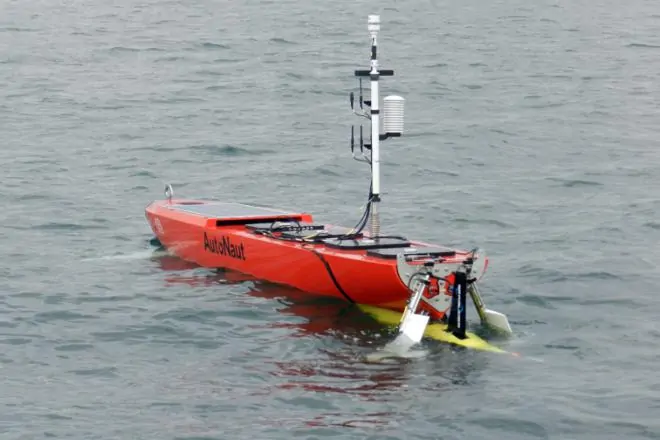AutoNaut and the University of East Anglia (UEA) have partnered to develop a new unmanned surface vessel (USV) designed to deploy research equipment in remote and inaccessible ocean locations.
The ‘Caravela’ is based on an AutoNaut USV, adapted to carry and release an underwater glider. The Seaglider, which can dive to depths of 1,000 metres and navigate the ocean for months, will carry a range of sensors to collect data for research on ocean processes that are important for climate.
Built by AutoNaut Ltd, the five-meter-long AutoNaut can be deployed from a beach or ship and can wait in position until the Seaglider is ready to be released by remote pilots.
Propelled by the motion of the waves, the USV can carry a range of sensors for meteorology and/or oceanography, including atmospheric pressure, air temperature and humidity, wind speed and sea surface temperature. Its systems and sensors are powered by solar panels and it is designed to withstand heavy seas, with self-righting functionality. It is piloted using satellite communication.
Prof Karen Heywood, of UEA’s Centre for Ocean and Atmospheric Sciences, came up with the idea for Caravela, having identified the need for a robotic platform that could deploy the Seaglider.
Prof Heywood said: “We are really excited to have worked with AutoNaut UK on the development of Caravela. We can now send a Seaglider into the middle of an ocean basin without having to use a ship, and where it is too dangerous to send one.
“This means we can reserve the glider battery for the science, so it will have longer endurance. It also gives us the ability to more accurately decide when to release the glider, for example ahead of the spring bloom or an extreme weather event.
She added: “Having sensors on both the AutoNaut and the Seaglider means we’ll get simultaneous meteorological and oceanographic measurements, giving us a more detailed picture of conditions at the study site and helping to further our understanding of factors affecting our climate.”
The design, build, and science missions of Caravela are funded by a €3.5 million research grant from the European Research Council awarded to Prof Heywood.
Caravela is being tested in the Atlantic Ocean, off the coast of Barbados, as part of a major international experiment to track the formation of clouds and their role in the climate system. Launched from shore, Caravela will make her way to an ocean area to the east of Barbados, known as Tradewind Alley.
The UEA team will use combined Caravela and glider measurements to understand how the ocean temperatures affect the layer of air above, and how the winds and sunshine affect the top tens of meters of the ocean.
Pete Bromley, AutoNaut’s Managing Director, said: “It’s been a fantastic and rewarding challenge working with the world-class team at UEA. Deploying an ocean robot on an ocean robot is ground-breaking science.”
The long-term aim is to use Caravela in the Antarctic and anywhere else that is remote or difficult to access.



















